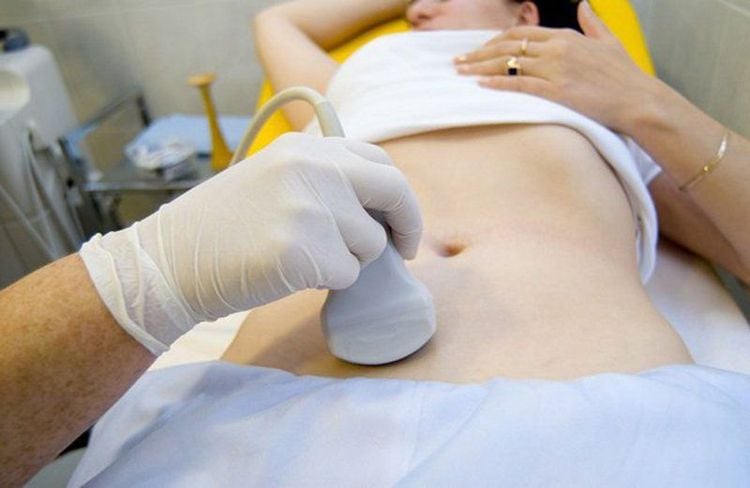This is an automatically translated article.
The article is professionally consulted with Master, Doctor Tong Diu Huong - Radiologist - Department of Diagnostic Imaging - Vinmec Nha Trang International General Hospital.Pelvic ultrasound is a technique that uses sound waves to create images of the inside of the pelvis. Therefore, when pelvic inflammatory disease is suspected through clinical symptoms, the doctor will appoint a pelvic ultrasound method to observe the organs and the solid, homogeneous structure of the organs located in the pelvis.
1. What is pelvic inflammatory disease?
Pelvic inflammatory disease is an inflammation of the upper genital tract and is an infection of the female reproductive organs, which are the uterus, cervix, ovaries and fallopian tubes.Pelvic inflammatory disease is usually caused by having unprotected sex with someone who has gonorrhea, chlamydia or other sexually transmitted diseases. In addition, pathogenic bacteria can also enter the body when the female reproductive organs are open such as: Abortion or abortion, childbirth, miscarriage, IUD insertion or when performing other procedures. procedure to insert an instrument into the uterus. These conditions can cause scarring of a woman's fallopian tubes and ovaries, which can make pregnancy more difficult or an ectopic pregnancy, dangerous to a woman's overall health. women.
Pelvic inflammatory disease often has no specific symptoms.
Some women do not know their condition until it becomes difficult to get pregnant or the disease progresses to chronic pelvic pain. However, some symptoms of pelvic inflammatory disease can appear from mild to severe such as:
The patient has a fever with pain in the pelvis, lower abdomen or low back from mild to severe; In some cases of abnormal vaginal discharge with a large amount and strong odor, the doctor will appoint a pelvic ultrasound to determine the cause of the disease; There is abnormal bleeding after sex or between menstrual cycles; In addition, people with pelvic inflammatory disease may experience chills, nausea or vomiting, fatigue, frequent urination and pain when urinating, menstrual disorders. Therefore, if you notice the above signs, the patient should go to a medical facility for examination, because if left for a long time, pelvic inflammatory disease will progress more seriously, so it is more difficult to treat, dangerous to the patient's health.

2. Can ultrasound detect pelvic inflammatory disease?
Pelvic ultrasound is a technique that uses sound waves to create images of the inside of the pelvis. A pelvic ultrasound looks at a woman's bladder, ovaries, cervix, uterus, and fallopian tubes.Can ultrasound detect pelvic inflammatory disease? Accordingly, when pelvic inflammatory disease is suspected through clinical symptoms, the doctor will appoint a pelvic ultrasound method to observe the organs and solid, homogeneous structures of the organs located in the pelvis. Pelvic ultrasound techniques can be performed in three ways:
Abdominal ultrasound: The transducer is moved back and forth over the patient's lower abdomen. This test is usually done to find large fibroids or some other problem. Transrectal ultrasound: This is a technique where the transducer is shaped to fit the rectum. This method can check for problems in men or women. Transvaginal Ultrasound: The transducer of the ultrasound machine is shaped to fit the female vagina. In some cases, your doctor may order an abdominal wall ultrasound and a transvaginal ultrasound to look at the entire pelvic area. With these types of pelvic ultrasounds, the ultrasound transducer sends reflected sound waves to the computer, which forms the images that are displayed on the screen.
Besides, pelvic ultrasound is also indicated by doctors in other cases such as: Finding an intrauterine device, evaluating tumor growth, monitoring fetal growth in pregnant women , confirm the pregnancy is in the uterus or not,...

3. Pelvic ultrasound procedure
Step 1: Prepare for pelvic ultrasound If you have had X-rays with contrast material in the past 2 days, you should notify the sonographer. At the same time, you should wear loose clothes to make the ultrasound easier.For abdominal ultrasound, the doctor will ask to drink 4 to 6 glasses of water about 1 hour before the ultrasound to fill the bladder, making the ultrasound image clearer. If the ultrasound is transrectal, an enema may be needed before the ultrasound, and if the ultrasound is transvaginal, tell your doctor if you are allergic to latex so that he can use an alternative method, such as a cap. no rubber cap on transducer before ultrasound.
Step 2: Perform pelvic ultrasound For abdominal ultrasound, the patient will be instructed by the doctor to lie on his back on a mattress, a layer of Gel will be applied on the patient's abdomen to help improve the quality of the sound waves. than. The doctor will move the transducer gently over the lower abdominal wall to take pictures of the pelvic organs and blood vessels.
If transrectal ultrasound is indicated, the patient should lie on the left side with the knee slightly bent. Then, the doctor will lubricate the transducer and then gently insert it into the rectum, moving the angles to see the images inside the pelvis.
In case of transvaginal ultrasound, the patient needs to empty the bladder before the ultrasound, then the doctor instructs the doctor to lie on his back with his hips slightly raised. The transducer is lubricated with a gel and then gently inserted into the vagina. During an ultrasound, you should lie still so as not to injure the vagina and help the doctor see more clearly the images inside, this method can provide more information than a transrectal ultrasound.
Regarding risk factors, pelvic ultrasound may pose a slight risk of infection if transvaginal or rectal ultrasound is chosen. If a biopsy is required, there is a higher chance of infection. Therefore, if you notice an unusual discharge or fever after a pelvic ultrasound, you should notify your doctor.
Pelvic ultrasound is a quick and effective way to detect and diagnose pelvic inflammatory disease. If you suspect you have pancreatic disease, you can come to Vinmec International General Hospital System, one of the leading prestigious hospitals in the country, Vinmec uses current generations of color ultrasound machines. the most modern in examination and treatment for patients. One of them is GE Healthcarecar's Logig E9 ultrasound machine with full options, HD resolution probes for clear images, accurate assessment of lesions. In addition, a team of experienced doctors and nurses will greatly assist in diagnosing and early detecting abnormal signs of the body in order to provide timely treatment for pelvic inflammatory disease.
Please dial HOTLINE for more information or register for an appointment HERE. Download MyVinmec app to make appointments faster and to manage your bookings easily.














